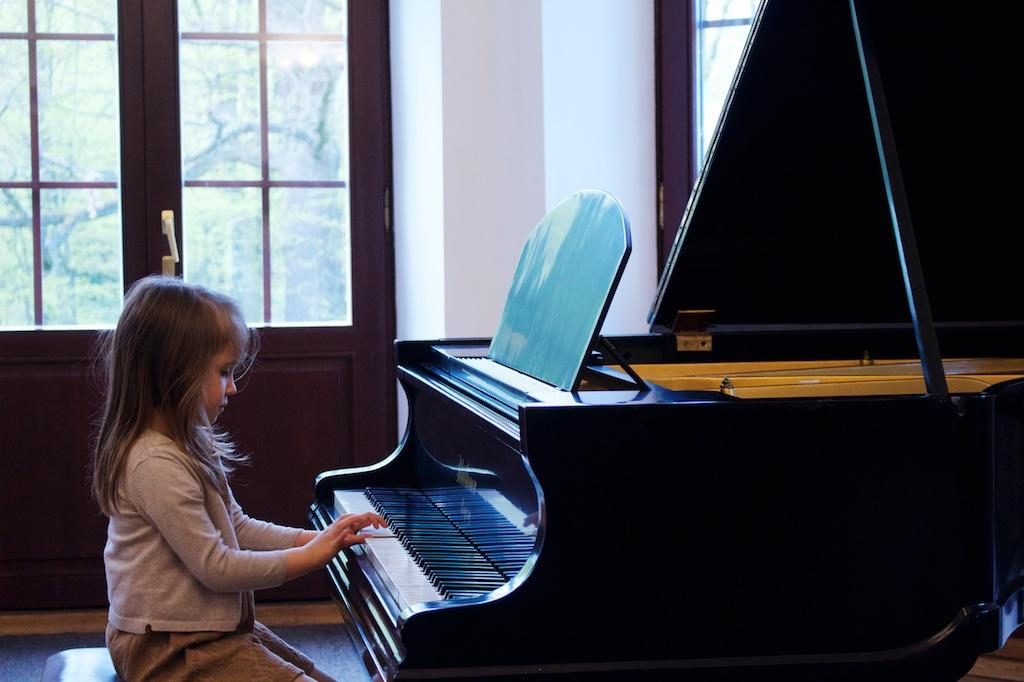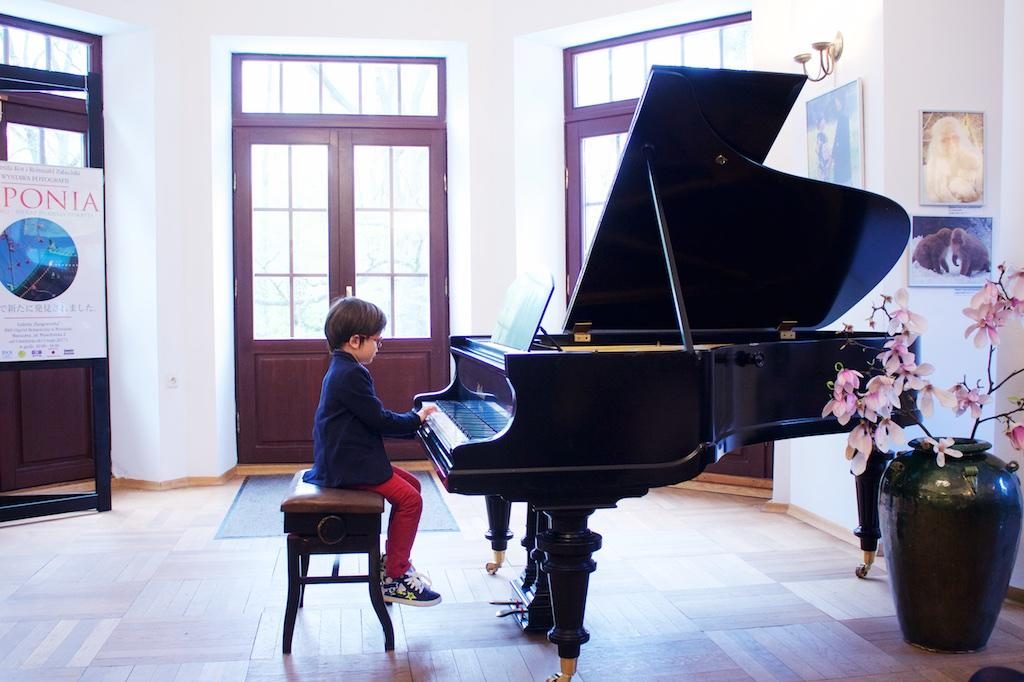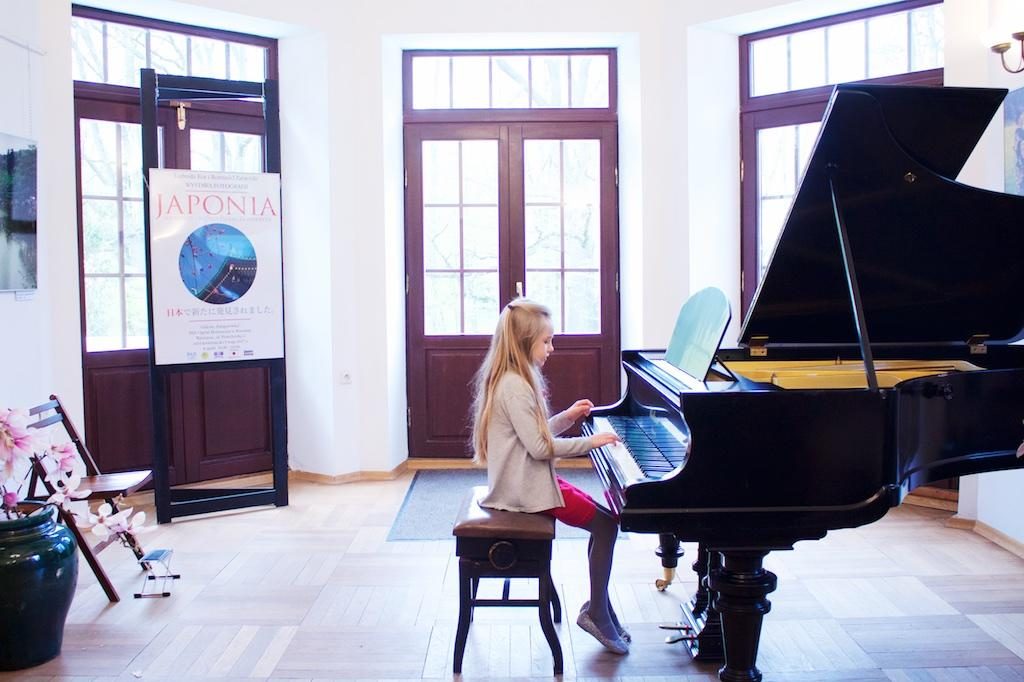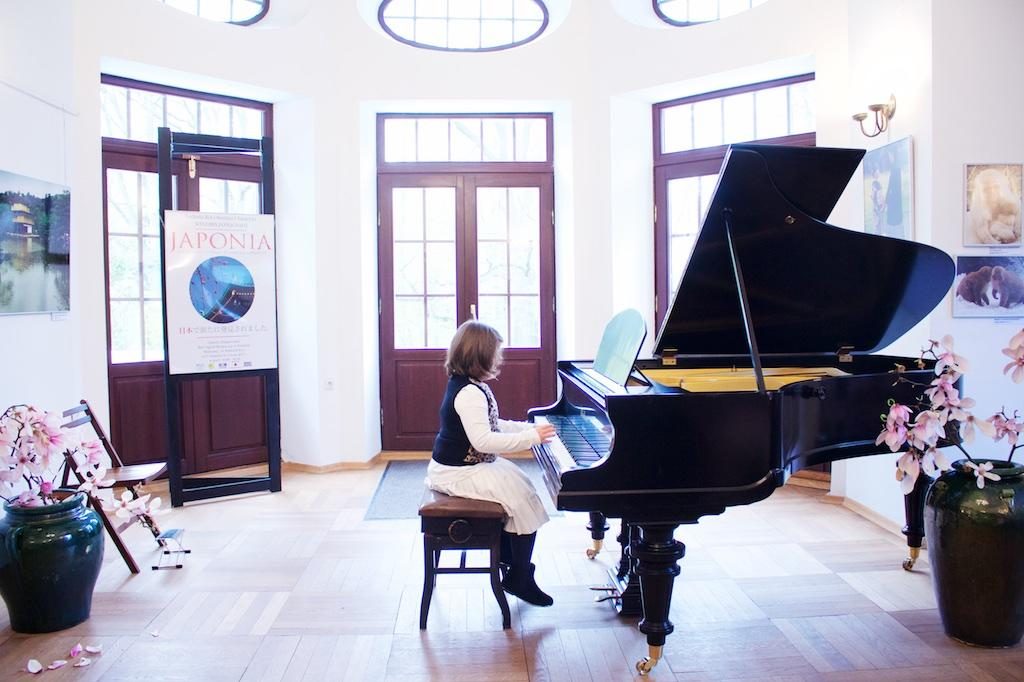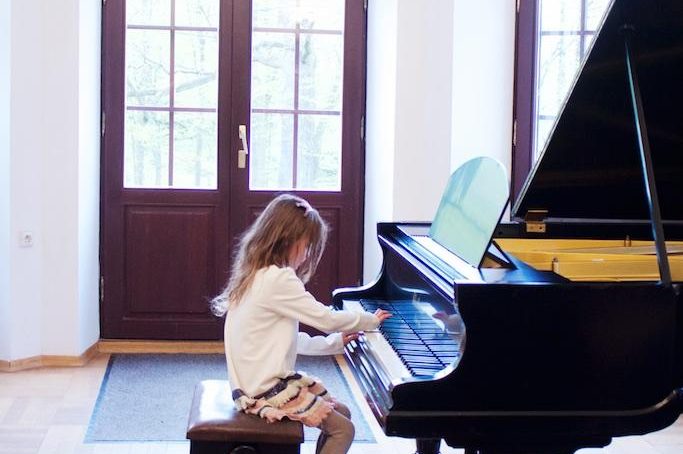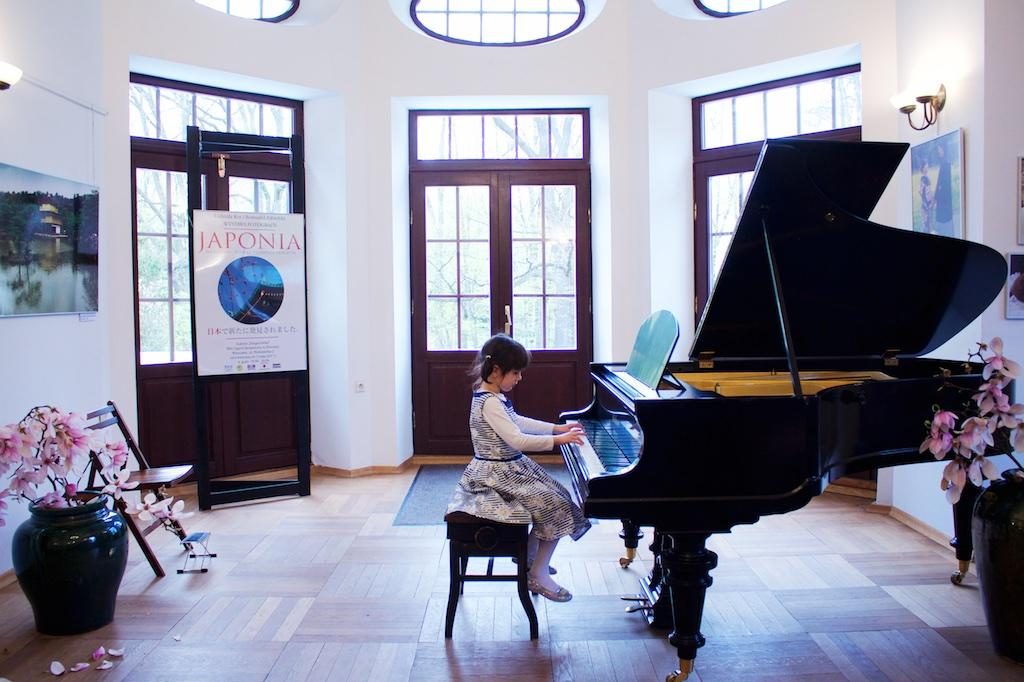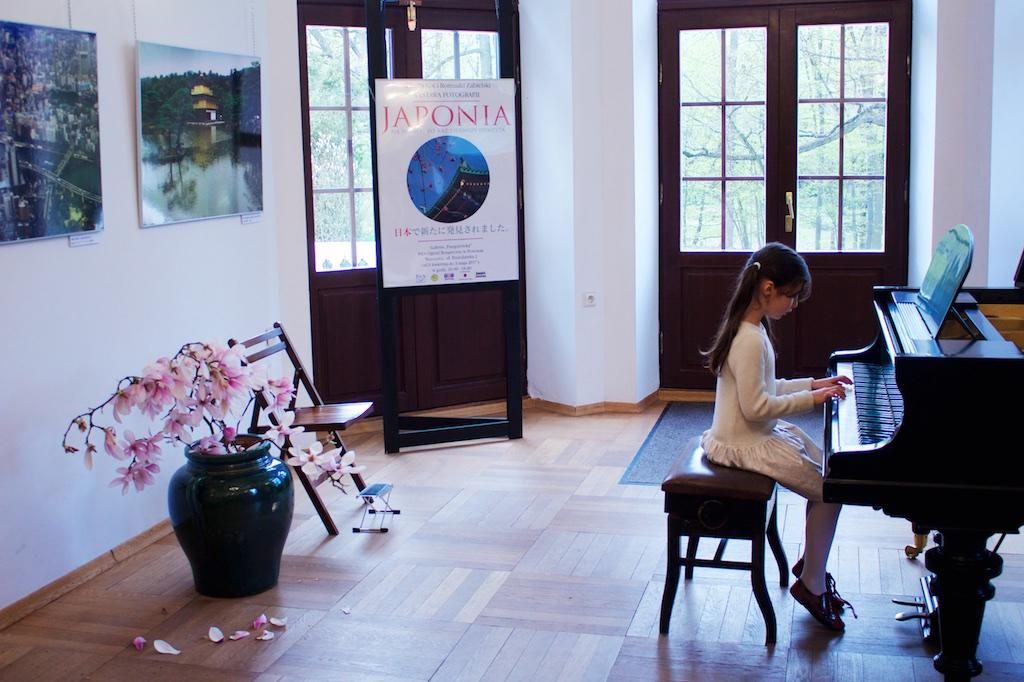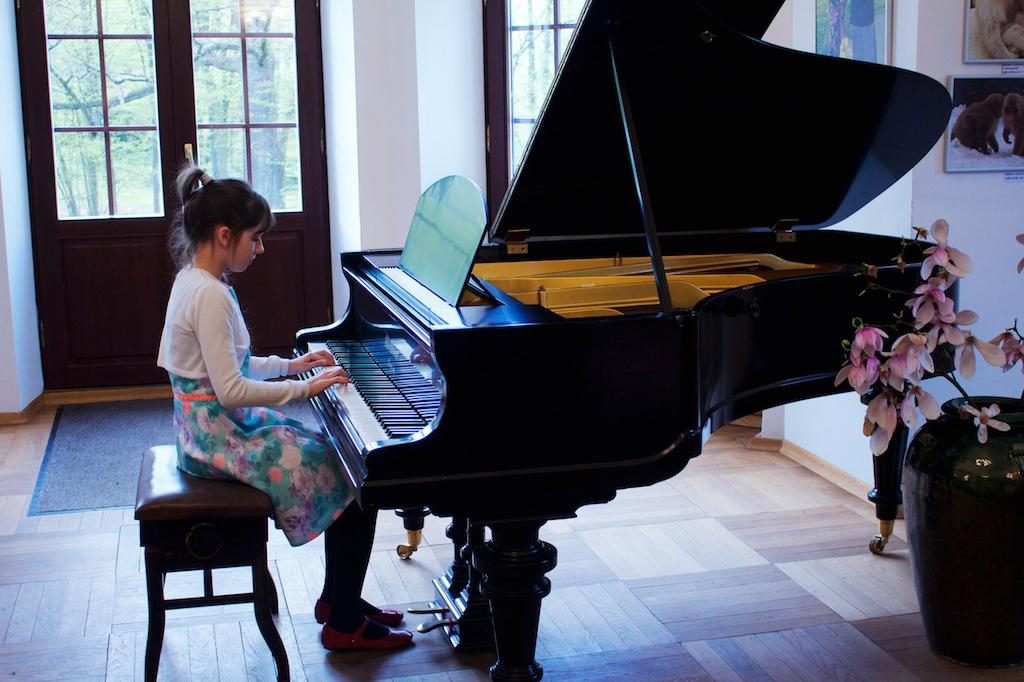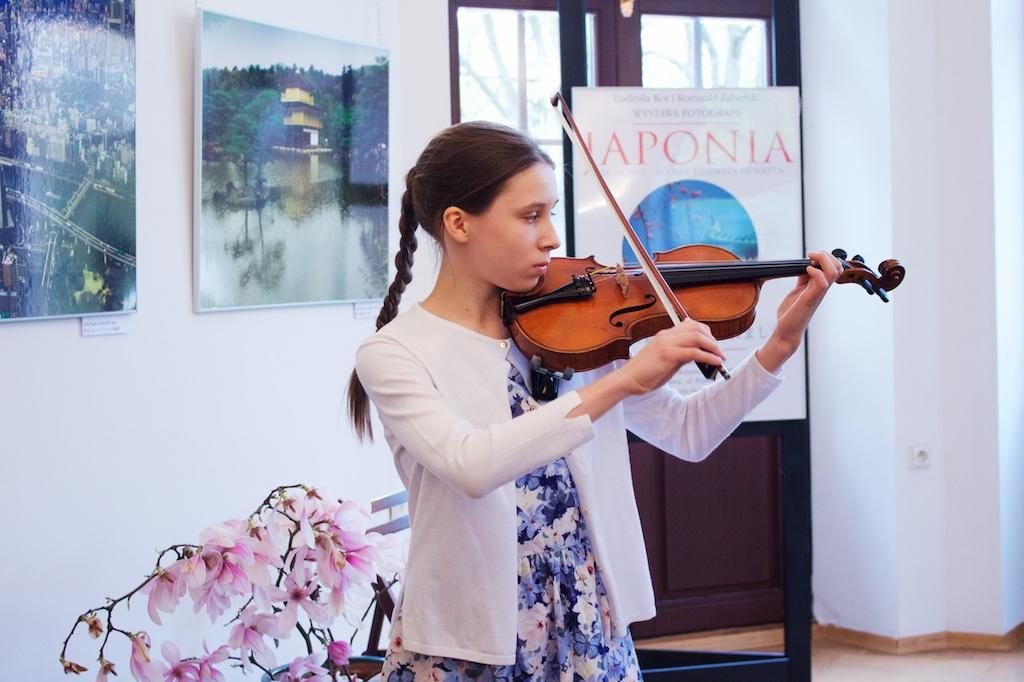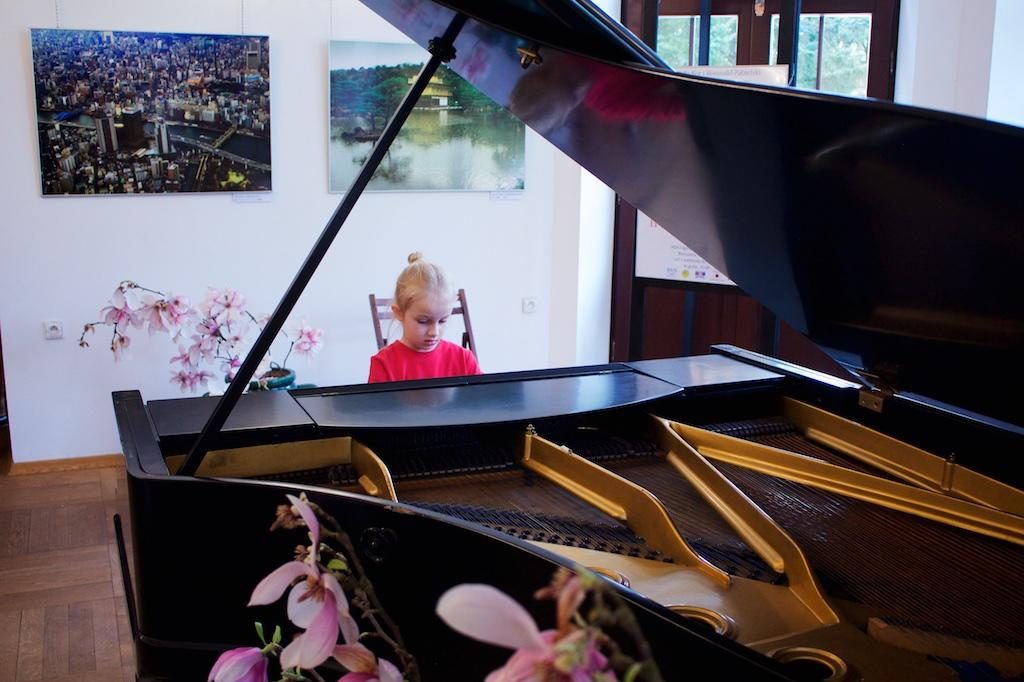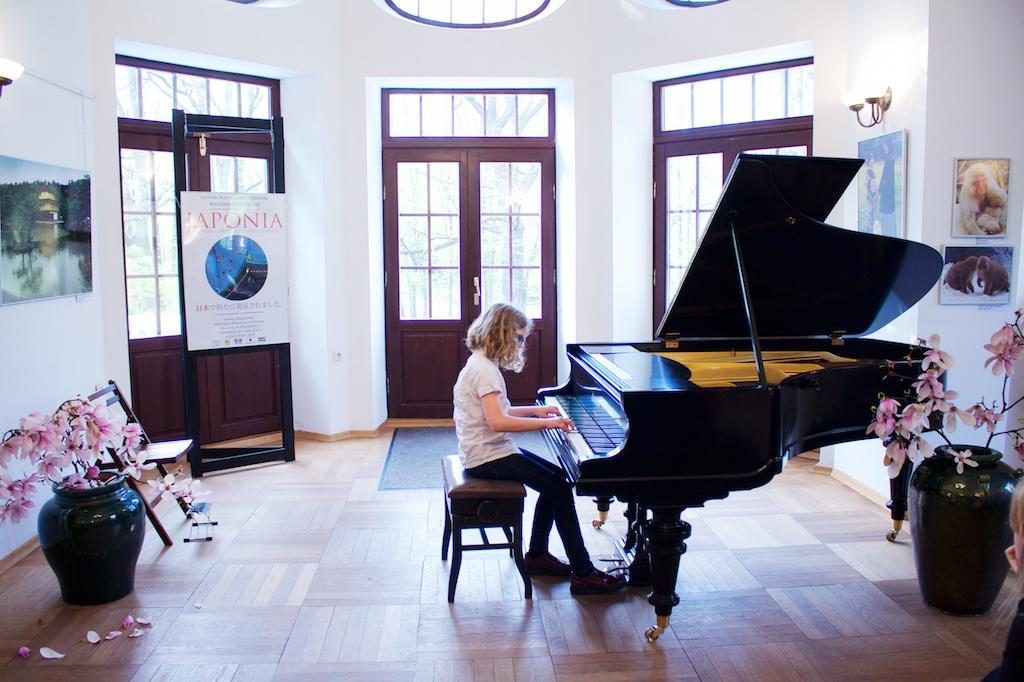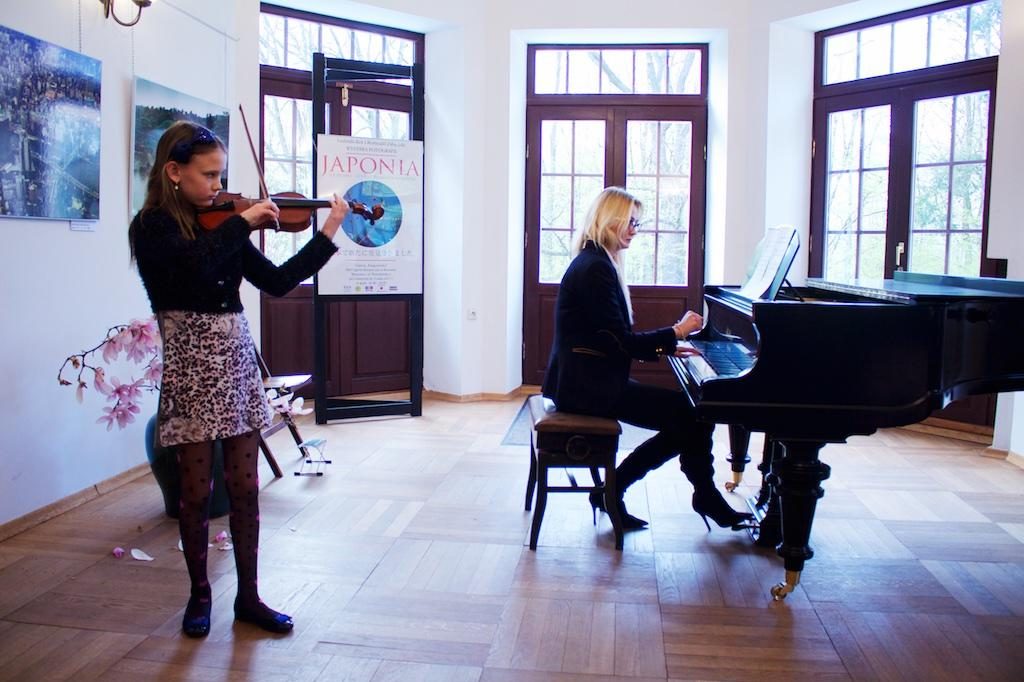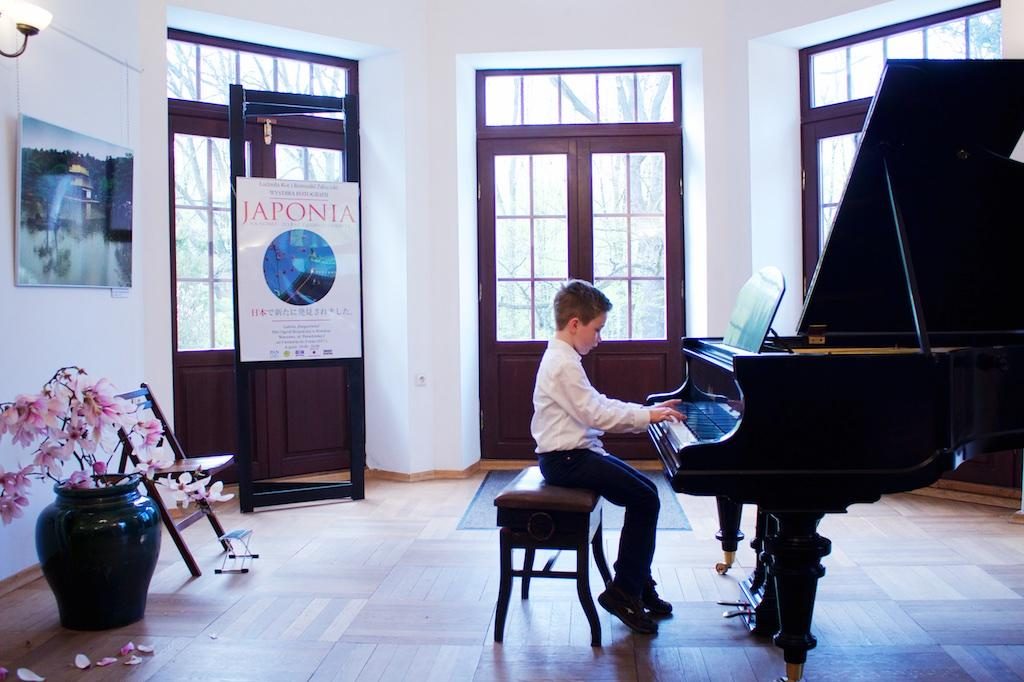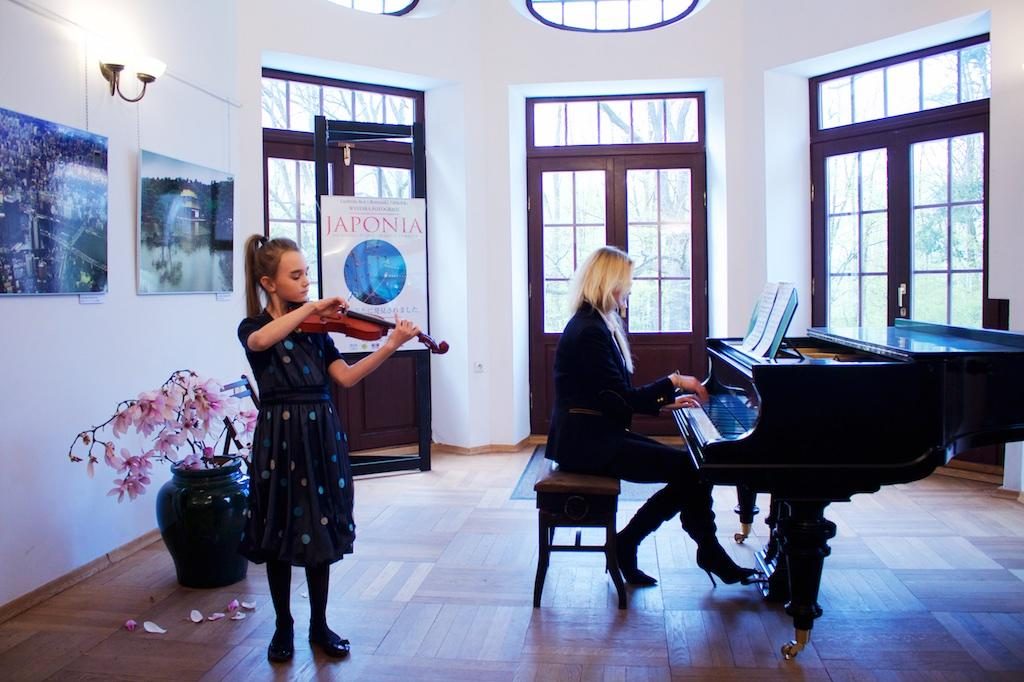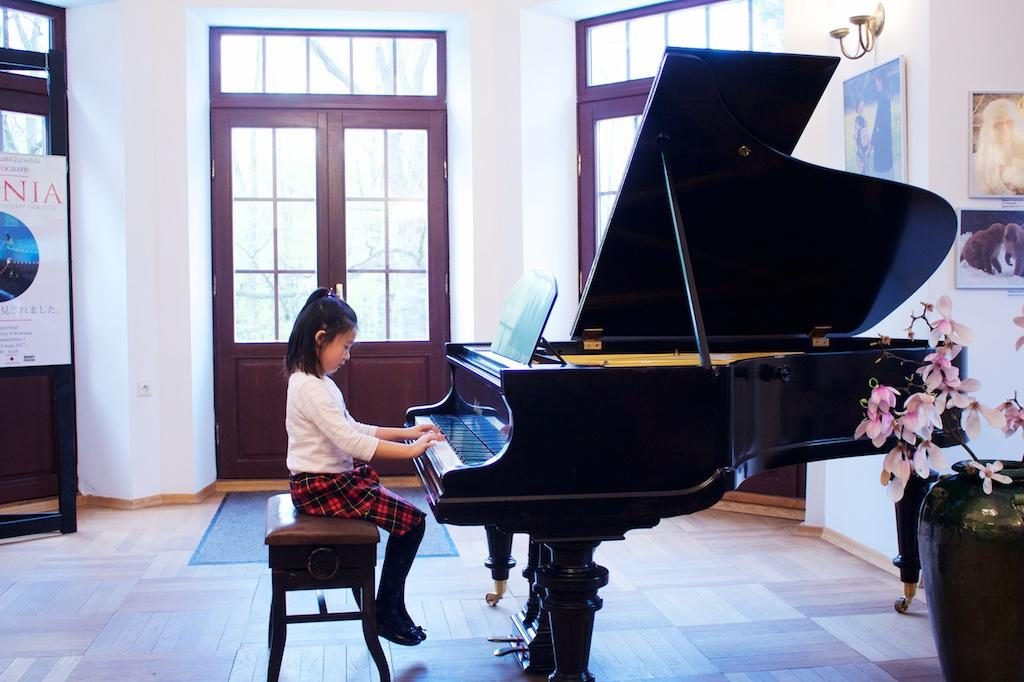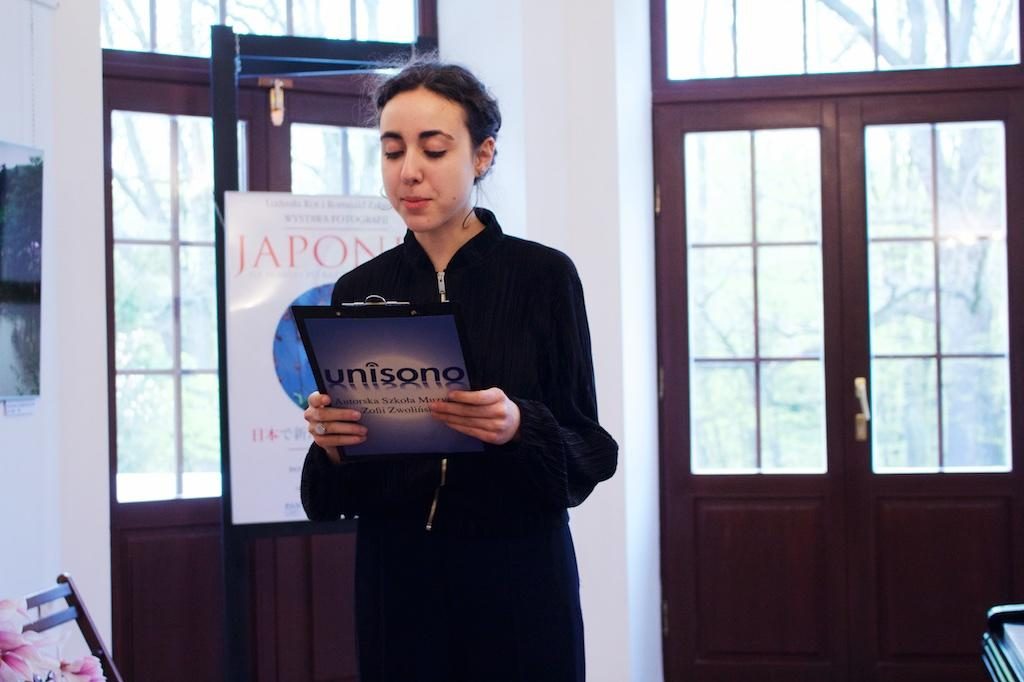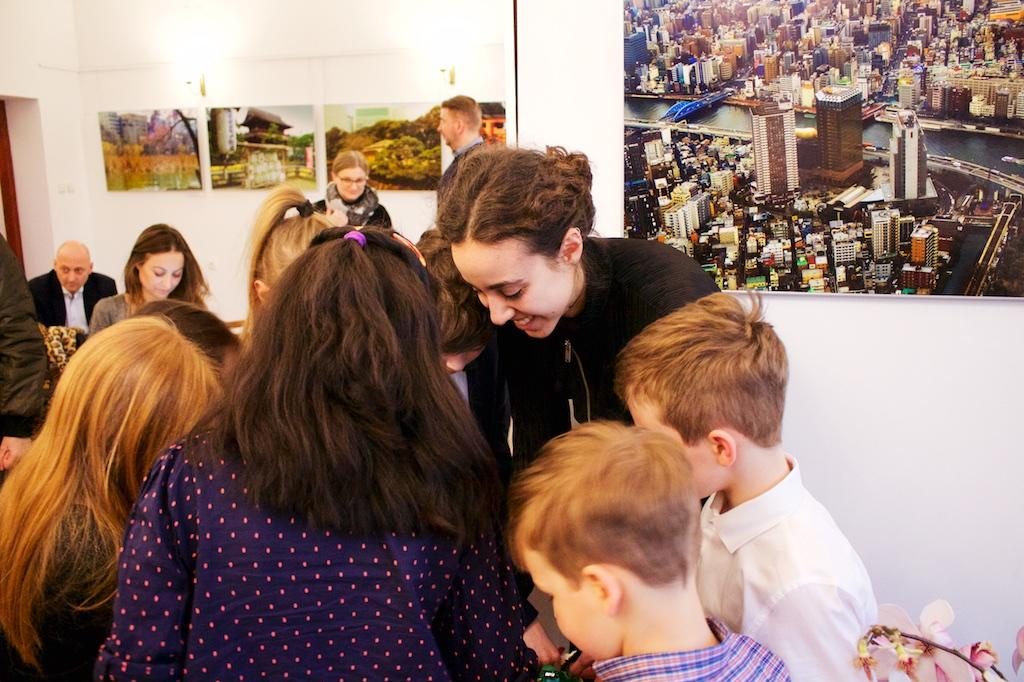This year, our Spring Concert 2017 was held on April 22nd . We met at the classic manor Fangorówka at the Polish Academy of Sciences Botanic Garden in Powsin. It was chilly. Outside, in the garden, frozen buds on magnolia trees created a melancholy mood.
Spring concert can be special for a variety of reasons. One reason might be that it marks the beginning of a new season and can symbolize new beginnings and a sense of renewal. Spring is also a time of year when the weather is often more pleasant, which can make outdoor concerts more enjoyable. Spring concerts may also be special because they provide an opportunity for students to come together and perform for an audience after half a year of tuition, which can be a rewarding and enjoyable experience for both the performers and the audience.
In the concert hall, however, the atmosphere was warm and joyful. Color dresses of the soloists created a nice counterbalance for that cloudy spring afternoon.
As the snow melts and flowers begin to bloom, a sense of warmth and renewal invades our senses. Spring, with its vibrant colours and living essence, has been a constant source of inspiration for many classical composers, culminating in what we now call ‘spring’ classical music. Not just background melodies, but powerful storytellers that allow us to connect with nature on a profound level.
Educational institutions play an enormous role in keeping this timeless classical genre alive by providing platforms for young musicians to immerse themselves in the reception, interpretation and transmission of these significant compositions. The inspirational power of classical music in school concert performances is not just about producing beautiful melodies – it ensures that our next generation grows up with an appreciation for one of mankind’s most artistic expressions. Indeed, nurturing young talent is like passing on a torch – we cannot claim to predict exactly where its light will go, but we can ensure that it continues to shine as brightly as ever.
Concert Performances
The concert was opened by Natalya Voloshyna who performed the Ist part of Ludvig van Betthoven’s Spring Sonata.
The Julia Levyuk class of piano was represented by:
- Sisters Marcelina and Michalina Lubowickie. Marcelina played two songs from the piano pedagogics: Fairy-tale about birds and Kitten. Michalina did two songs: Exercise and Polka.
- Lara Kistak performed Leopold Mozart’s Menuet and
- Nicole Obarzanek played Janina Garscia’s miniature Two little goatlings.
- Pola Rossokhina played Gnesinai’s Etude and Menuet.
- And Ania Wilkins who performed Wolfgang Amadeus
Mozart’s Romanza and Dymitr Kabalewski’s Clown.
Piano class
Konstancja Kawalla-Kosiec class of piano was represented by Aleksander Osia who did Wanda Cmielowska’s Party at the Dolls Place, and Władysława Markiewiczówna’s Jumping-jack dance.
From Krzysztof Komarnicki class of guitar
- Victor Obarzanek played John Whaitworth Gypsy dance,
- Andżelika Czigiloj performed Ferdinando Carulli’s Larghetto and Peter Nutali’s Serenade.
Magda Lewandowska piano class was represented by:
- Liza Tebbens who played Rawley’s Little Chinese Boy;
- Nathan Caniard who did the 3rd part of Sonatina op. 51 no. 4 by Janina Garscia:
- Jojo Yang Yi played Etude in C-Major
- Zosia Kowalska executed Etude in G-Major of the same composer
- Emilka Wilkins played Allegretto
- Hania Głąb executed Johann Sebastian Bach Invention for Two Voices in d-minor;
- Franek Kulig played Ludwig van Beethoven Sonatina in G-Major.
- Guests of the concert were piano students of Magda Lewandowska:
- Jeremi Nowakowski executed Drum – a song from the piano pedagogics;
- Zuzia Depczyńska played Rowley’s Little Chinese Boy,
- and her sister, Lila Depczyńska, performed Johann Sebastian Bach’s Musette.
Zofia Zwolińska class of violin was represented by:
- Madlein Hoijer played Teddy Bear With a Little Doll by Maria Kaczurbina,
- Marysia Frączak executed Izaac Dunajewski’s Lullaby;
- Pola Karłowska presented Etude by Witold Krotkowski;
- TK Lee played the 3rd part of Concerto in a-minor by Antonio Vivaldi;
- Ella Bai executed Rondo (the 3rd part of Concerto in D-Major) by Antonio Vivaldi.
- At the end of this Annual Spring Concert, Ella Bai appeared again and performed Carl Bohm’s Introduction and Polonaise.
- The Unisono Musical Academy Annual Spring Concert 2017 was narrated by Liza Maria Pietraga.
After the musical program was completed, Zofia Zwolińska, Director of the Unisono Musical School, expressed her acknowledgements and thanked all the soloists and professors for their work which brought so much joy and to the entire audience for its warm reception an applause.
Finish of the concert
Finally, at the end of the day, the young soloists and their little brothers and sisters were welcomed as usual to the tray full of sweet candies and chocolates served by Liza Maria Pietraga.
Classical Music of School Spring Concert
Watching a school spring concert transform into a glorious symphony of classical music is nothing less than experiencing magical enchantment unfold before your very eyes. It’s remarkable to watch young talents translate the complexities and subtleties of masterpieces by Mozart, Beethoven or Bach into an artful demonstration that touches every soul in the audience. Such an experience not only inspires creative thought, but also confirms why classical music, often considered a niche genre, has endured through the centuries.
Classical music at the School Spring Concert encourages students to combine discipline with freedom – embodying precision while sketching emotional landscapes through harmony and dynamics. It disarms the casual listener with its elegant simplicity, while creating intricate layers for those who delve deeper. This tastefully curated communion between the compositions of past masters and budding musicians underlines how this great tradition transcends time and age – forming an unbroken chain that links our collective artistic heritage across generations.
This annual spectacle brings together brilliant young minds to create a glorious symphony, painting bright strokes of rhythm and harmony on the canvas of spring. The Classical School Spring Concert is indeed an unmissable celebration where music dances with fine artistry, moving and uplifting your soul at the same time. Prepare to be captured in its musical saga!
Music history about composers works featured during concert
By exploring the world of classical music and learning about the works and lives of composers, we can increase our understanding and appreciation of this genre. This type of music education helps us to investigate the history, context, and contributions of individual composers, which in turn enables us to gain a deeper understanding of the creative process and the cultural and historical forces that have influenced classical music.
By delving into the world of classical music and immersing ourselves in the works and lives of composers, we open up a world of understanding and appreciation. Composers are more than just names on a programme or dusty figures from history books; they are the creators who gave birth to the powerful emotions and profound stories that permeate their compositions. Learning about their lives adds depth to our experience of their music and allows us to connect on a personal level with the pieces we hear. Understanding the context in which a composer lived, their struggles and triumphs, can shed light on the nuances of their work and give us an even richer appreciation of what they created.
When we learn about composers, we gain insights not only into their creative processes, but also into how they sought to express themselves through sound. Each composer had a unique musical voice, shaped by cultural influences and personal experiences. As we explore these different approaches to classical music, our own musical horizons expand. We begin to see patterns across periods and styles, and how composers built on what came before them while leaving their own distinctive mark. Such discoveries deepen our listening experience in concert halls or classrooms, as we can trace these connections between one piece or style and another first-hand.
Studying the lives of composers helps us to understand that behind every composition there is both a story waiting to be told and an emotion yearning to be felt. These men and women lived vibrant lives, full of passion, hardship, love affairs, political struggles – all of which shaped the way they wrote.
Music of Johann Sebastian Bach
Johann Sebastian Bach was a German composer and musician of the Baroque era who is considered one of the greatest composers in the history of classical music. He was born in Germany in 1685 and began his musical career as a choirboy in the Lutheran Church. He went on to study music and eventually became a highly respected organist and composer.
One cannot help but marvel at the incredible marriage of mathematical precision and seductive beauty embedded in Bach’s music. His signature counterpoint technique – the simultaneous interweaving of multiple melodies – has been heralded as both unimaginably complex and strangely engaging, like an intriguing puzzle for the ears that unfolds layer by layer into graceful revelation. Whether it’s the rhythmic freedom of his partitas or the fervent chorales that illuminate church halls, the music of Johann Sebastian Bach remains an endless source of enchantment that touches hearts across the ages.
Bach is known for his contributions to the classical music repertoire, which includes a wide range of instrumental and vocal music, as well as opera and other stage works. He composed a large number of works for a variety of instruments, including piano, violin and other instruments, as well as ensemble works and vocal music.
Bach’s music is known for its technical demands and virtuosity, as well as its expressive melodies and beautiful harmonies. His music has had a lasting influence on classical music and has been widely performed and recorded by musicians around the world.
When you delve into the genius of Johann Sebastian Bach, it is not only his music but also his intellectual prowess that fascinates. The mathematical precision and deep emotional resonance intertwined in his compositions truly bear witness to a mind that flowed freely between the arts and sciences, revealing an intelligence akin to the universal brilliance of Leonardo da Vinci.
Bach’s compelling masterpieces, replete with intricate fugal architecture and polyphonic latticework, represent perspective-changing milestones in the evolution of musical language. His uncanny ability to layer melodies creates a sonic universe brimming with vibrancy and depth; Bach invites – no, compels – the listener to actively participate in the hunt, seeking resolution within complex harmonic labyrinths. This isn’t just a simple proliferation of melody; it’s a thrilling kaleidoscopic journey through sound time: crystalline moments of simultaneous order and chaos suspended in sonic infinity. Herein lies the genius of Johann Sebastian Bach – a celestial cartographer who maps stars into symphonies – constellations radiant with charisma, orbiting spheres composed by none other than himself.
Music of Carl Bohm
Carl Bohm was a 19th century German composer and musician, best known for his contributions to the classical music repertoire. He was a prolific composer, producing a large body of work that includes a wide range of instrumental and vocal music, as well as opera and other stage works.
Bohm’s music is known for its technical demands and virtuosity, as well as its expressive melodies and beautiful harmonies. He composed a wide range of works for a variety of instruments, including piano, violin and other instruments, as well as ensemble works and vocal music. Bohm’s music has had a lasting influence on classical music and has been widely performed and recorded by musicians throughout the world. He is considered a major composer of the 19th century and is recognised for his contributions to the development of instrumental music.
One aspect that sets Bohm’s music apart is his ability to evoke a range of emotions within each piece. Whether through the tender sweetness of his love songs or the playful energy of his dance-inspired works, Bohm demonstrates an innate understanding of how to connect with listeners on an emotional level.
Bohm’s keen sense of melody also shines through in his compositions. His melodies flow effortlessly from one note to the next, creating a sense of fluidity that keeps the listener engaged from beginning to end. It is this ability that allows even those unfamiliar with classical music to appreciate and enjoy the beauty found within Bohm’s musical creations. With its thoughtful tone and captivating qualities, it leaves us wondering why such remarkable compositions have been overshadowed by those more famous in their time. Immerse yourself in Carl Bohm’s repertoire and discover for yourself the hidden gems waiting to be rediscovered in this fascinating composer’s catalogue.
Music of Ferdinando Carulli
When exploring the music of Ferdinando Carulli, one cannot help but be captivated by his ability to balance both technical complexity and emotional depth. Carulli was a master of the classical guitar, and his compositions display an intricate web of melodic lines and harmonies that weave together seamlessly. What sets Carulli’s music apart is his unique ability to evoke a range of emotions in the listener. From the tender melancholy of his slow movements to the playful liveliness of his fast-paced compositions, Carulli’s music speaks directly to the soul.
Ferdinando Carulli was an Italian composer and musician active in the early 19th century. He is known for his contributions to the classical music repertoire, particularly his compositions for guitar and his method books for guitar.
One aspect that makes Carulli’s music so captivating is its accessibility. While he was undoubtedly a virtuoso performer and composer, he had a gift for creating pieces that were accessible to players of varying skill levels. His etudes, in particular, are widely used by guitarists as valuable practice material that not only helps develop technique, but also showcases Carulli’s musical ingenuity. This accessibility allows musicians and listeners alike to engage with Carulli’s compositions on many levels – whether as performers seeking technical growth or simply as lovers of beautiful melodies.
In many ways, Ferdinando Carulli can be seen as a bridge between the classical tradition and romantic expression. His works display elements characteristic of both periods, while retaining their own distinctive voice. The elegance and grace reminiscent of Mozart can be heard alongside moments of heartfelt passion reminiscent of Schubert or Beethoven. By immersing oneself in the music of Ferdinando Car
Carulli was born in Naples, Italy in 1770 and began his musical career as a violinist in the Royal Court Orchestra. He later became interested in the guitar and began composing music for the instrument. His compositions for guitar are known for their technical demands and virtuosity, as well as their expressive melodies and beautiful harmonies.
Carulli’s music has had a lasting influence on classical music and has been widely performed and recorded by musicians throughout the world. He is considered an important composer of the 19th century and is recognised for his contributions to the development of guitar music.

